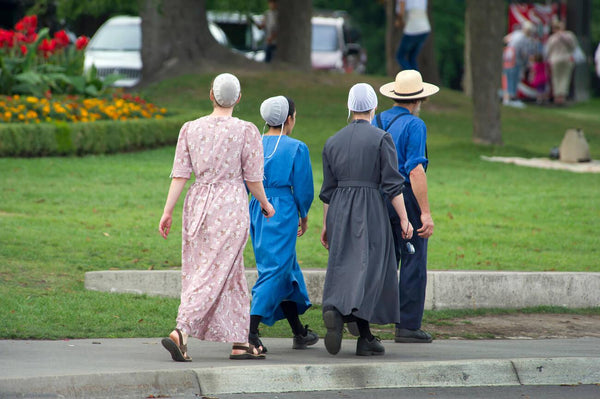Mennonite clothing rules showcase a unique approach to dress that promotes modesty, simplicity, and community values. Many people might see these practices as old-fashioned, but Mennonite dress codes are thoughtful expressions of deep spiritual principles that go beyond just appearance. You can spot traditional Mennonite attire by its plain-colored dresses, practical garments, and prayer caps or scarves that set them apart from modern fashion trends.
The way Mennonites dress varies quite a bit between different communities. Conservative groups stick close to Amish clothing traditions, with women wearing long skirts and men in plain suits [-3]. Modern Mennonite communities have adapted differently. Their membership now includes Hispanic, African American, and Asian members who make up 20-25 percent of the total, and they often interpret modesty rules in ways that blend with current cultural norms. The difference between Mennonite and Amish clothing helps us understand how these communities use dress to express their values. This piece takes you into the world of Mennonite dress practices and shows both the traditional rules and how they’re changing with time.

The Core Values Behind Mennonite Dress
Spiritual values that exceed mere fashion choices form the foundation of every Mennonite dress code. Three interconnected principles have shaped their clothing decisions through centuries, resulting in their distinctive appearance.
Modesty as a spiritual principle
Modesty embodies a spiritual commitment that goes nowhere near simple clothing coverage for Mennonites. One conservative Mennonite woman explained, “The biggest reason I wear veiling is because I believe that God specifically said that women should cover their heads”. This practice symbolizes being “under the headship of Christ” and acknowledges traditional gender roles within their faith structure.
Biblical teachings shape Mennonite clothing rules. These teachings encourage believers to “put a greater value on what is inside of us than on our appearance”. The modest dress shows their inner spiritual values. One practitioner noted, “Modesty is not just about the clothes we wear but a reflection of our inner values and beliefs”.
Mennonite attire shifts focus toward character development, unlike mainstream fashion’s emphasis on individual expression through appearance. One adherent explained, “Dressing simply is a way of saying and of feeling deep within myself that I am worth more than my clothes or my sex appeal”.
Simplicity and humility in daily life
Mennonite practices stem from the Anabaptist tradition, which has always emphasized simplicity. The Strasbourg Conference of 1568 directed that clothing should “hold to the plain and simple style” and that nothing should be made “for pride’s sake”.
This commitment to simplicity shows through:
- Plain-colored garments with minimal embellishments
- Practical designs suited for work and daily activities
- Economical fabric choices that avoid unnecessary expense
- Durable construction meant to last for years
This simplicity reflects a theological position at its heart. “The historic roots of the Anabaptist faith called Mennonites to live in the spirit of the Sermon on the Mount, unconcerned about worldly possessions and trusting in God to clothe and feed them”. Function takes priority over fashion, substance over style.
The role of community identity
Community consensus determines dress codes in many Mennonite groups, making their clothing rules unique. “The congregation as a whole discusses and decides about matters like clothing styles (suspenders, jackets in the summer, skirt length, shirt color, facial hair, headcoverings), revisiting it before their bi-annual Communion if there are things to discuss”.
Mennonite dress varies between communities rather than reflecting personal choices. One woman noted, “I don’t really feel like everything my church asks of me is my conviction, but I feel like it’s a privilege to be part of that church. I’m committed to being part of the brotherhood and therefore adhering to those things”.
Scholars call the distinctive mennonite vs amish dress “a badge of membership”. A Mennonite bonnet “stands as a clear symbol of religious commitment and faith that reflects a woman’s role within her congregation and family life”. These visual identifiers strengthen the community’s bonds.
The plain dress marks Mennonites as “a peculiar people distinct and separate from society”. This separation reflects their understanding of being citizens of “Two Kingdoms”—belonging to both earthly society and God’s kingdom, with primary allegiance to the latter.
Key Elements of Traditional Mennonite Attire
Traditional Mennonite attire shows the community’s spiritual values in physical form. Each clothing element upholds modesty and simplicity by design. These distinctive items create a visual identity that changes among Mennonite communities of all sizes.
Prayer caps and head coverings
Prayer caps stand out as the most recognizable part of Mennonite women’s attire. These white head coverings symbolize purity and demonstrate reverence, spirituality, and submission to God. Simple fabrics with minimal decoration make up these caps. Each community has its own style – from small prayer coverings to structured caps like in Amish communities.
Conservative Mennonites choose solid white caps. More progressive groups might add subtle lace, embroidery, or lightweight fabrics. Russian Mennonite communities prefer black kerchiefs instead. These head coverings hold special meaning during worship services as symbols of faith and modesty.

Cape dresses and long skirts
The cape dress is the life-blood of traditional Mennonite clothing rules for women. This unique garment adds modesty through a double-layered bodice area with extra fabric (the “cape”) covering the chest and back. A typical cape dress has:
- A square or V-shaped cape that minimizes the female form
- A long, full skirt reaching below the knee or to the ankle
- Simple, practical design with minimal decoration
- Durable construction for daily work
Long skirts remain essential to Mennonite dress. Women can do their daily tasks comfortably while following tradition in these garments. Simple blouses or tops paired with these skirts create a timeless look that stays away from fashion trends.
Muted colors and plain fabrics
Traditional Mennonite clothing uses muted, neutral tones without strict color rules. Conservative groups like solid colors and avoid flashy patterns, though some communities allow small prints. This choice of subdued colors shows their focus on humility and modest appearance.
Mennonite’s fabric choices differ from Amish traditions. Mennonites use slightly brighter colors and gentle patterns compared to Amish clothing. All the same, they keep an understated and modest look. Wool, cotton, and linen make up most garments because these materials last through daily work.
Minimal use of accessories
Traditional Mennonite women show their steadfast dedication to simplicity by avoiding makeup and jewelry. This practice reflects their belief in minimalism and rejection of vanity. Conservative communities prefer hair tied back in neat buns.
The difference between Amish and Mennonite dress shows up in practical details. Modern Mennonite clothing might include zippers, which some Amish groups avoid. Both groups share the same dedication to modest appearance.
Some Mennonite women wear plain aprons over their dresses, but this varies by community. Unlike Amish women who wear outer bonnets, Mennonites show more variety in their head covering styles based on their group’s traditions.
These clothing choices reflect functionality, modesty, and community identity – physical expressions that define Mennonite life’s spiritual values.
How Mennonite Men and Women Dress Differently
Mennonite communities show their religious culture through clothing, which creates clear differences between men’s and women’s dress codes.
How do Mennonites dress: men vs women
Women’s clothing rules are stricter than men’s in Mennonite communities. The traditional outfit for women has a simple knee or calf-length dress with a full skirt and long sleeves. You might see subtle touches like lace or embroidery. Their head coverings range from mesh coverings that hide most of their hair to small lace doilies.
Men’s dress codes are nowhere near as strict. They wear simple suits or shirts with trousers in solid colors. Their everyday clothes include button-down shirts, sometimes with subtle patterns, and plain trousers. They don’t need to wear distinctive items like suspenders.
Progressive Mennonite groups allow women to wear skirts and blouses instead of the traditional caped dress. Men can wear casual clothes like jeans and t-shirts. Yet modesty remains a core value in these communities.
Mennonite beard and grooming rules
Each Mennonite group has its own beard rules. The Church of God in Christ requires all male members to grow beards after baptism. Many conservative Mennonite men wear beards, but not all conferences make this mandatory.
Beards are fine but mustaches aren’t in many Mennonite communities. This rule comes from history rather than the Bible. One Mennonite man joked that some believe “you only get to heaven by a close shave”.
Beards symbolize humility. Some groups point to Biblical passages in Leviticus 19:27 and 21:5 to support this practice. This tradition dates back to the 1568 Strasbourg Conference of Swiss Brethren, which banned trimming hair or beards to match worldly styles.
Why men’s clothing appears less distinct
Mennonite men’s clothes look normal because they’re like mainstream men’s fashion. “A Mennonite man with loose-fitting slacks, a buttoned shirt and black shoes looks just like thousands of non-Mennonite men wearing similar clothing”.
Women’s Plain clothing stands out from modern fashion. Men’s clothes blend in with what working-class men wear. They buy their black work slacks, navy-blue work shirts, and brown or black work boots from the same stores as non-Mennonite men.
Even when Mennonite men wear distinctive items like suspenders or black hats, these pieces are popular among non-Mennonites too. The main difference is that Plain men avoid revealing clothes like shorts, swimsuits, or t-shirts. They stay modest even if their clothes don’t look unique.
Modern Mennonite Clothing and Evolving Norms
Traditional practices still dominate conservative Mennonite communities, yet Mennonite attire’s development has revolutionized their appearance in the last several decades.
Variations across progressive and conservative groups
Modern Mennonite clothing varies dramatically between different congregations. Conservative groups strictly follow cape dresses, prayer coverings, and modest attire rules. Progressive Mennonites have started to adopt mainstream clothing elements but managed to keep their core modesty principles intact.
The late 20th century saw roughly 20% of members in some Mennonite communities fully adopting fashion-forward clothing. Another 20% stuck to traditional anti-fashion dress, and the remaining 60% mixed both approaches. Many Mennonite women now buy modest contemporary clothing from mainstream stores instead of wearing exclusively home-sewn garments.
Use of modern fabrics and styles
Mennonite clothing rules have slowly adapted to include practical breakthroughs in the last century. Some groups now allow poly/cotton blends and other modern textiles. These materials offer better durability and comfort without compromising modest appearance.
Traditional garments have subtly changed in cut and design. Today’s conservative Mennonites’ cape dresses represent a 20th-century development rather than ancient tradition. Research shows that “many Mennonite women of the 19th century dressed fashionably, particularly in their younger years”.
Influence of culture and geography
Location and cultural context shape Mennonite dress practices profoundly. A historian noted that “Mennonites adapted their style to varying degrees based on where they settled—some embracing more interaction with society, which allowed for modest variation in dress”.
Dress codes changed gradually without formal announcements. Several elderly Mennonite women from Virginia “couldn’t remember exactly when standards on dress had changed”. One woman recalled that during the 1960s, it seemed “almost like every woman did what was right in her own eyes” regarding dress.
Employment outside Mennonite communities now drives many dress practice changes. Research shows a direct link between women’s work outside the home and “more frequent acceptance of fashionable dress and increasing levels of female agency” in certain Mennonite groups.
Mennonite vs Amish vs Quaker Clothing: A Comparison
Dissecting dress practices in Anabaptist traditions shows how clothing reflects religious values.
Amish vs Mennonite dress: key differences
Color and pattern choices mark the most visible difference. The Amish’s clothing strictly follows plain, solid colors in muted tones like black, navy blue, and brown. Mennonites allow prints and plaids in their garments, which gives them more room for expression. The Amish’s dress code has stayed unchanged for generations, while most Mennonite groups have moved toward more modern styles.
Head coverings and bonnets
Both groups employ head coverings, but with clear variations. Amish women’s distinctive heart-shaped white prayer covering, called a “kapp,” stays pinned to their hair. They remove it only to wash and style their hair. The kapp looks different from the black bonnet worn during winter or formal occasions. Mennonite coverings are much smaller, ranging from modest coverings to simple “doily” styles pinned on top of the head. Progressive Mennonites have largely abandoned the covering tradition.
Use of buttons, zippers, and patterns
Many Amish communities avoid buttons because they consider them too decorative. They prefer hook-and-eyes, straight pins, snaps, or even velcro to fasten clothes. Zippers remain off-limits. Mennonites, however, accept buttons and zippers as practical items.
Cultural symbolism in each group
Every clothing element holds deep religious meaning. Head coverings in both traditions represent submission—married women to their husbands, unmarried women to their fathers. Plain dress shows humility and modesty, and rejects modern fashion trends.
Mennonite clothing rules mean much more than just fashion choices. These dress codes reflect their deep spiritual dedication to modesty, simplicity, and community identity. Conservative Mennonite groups still wear traditional cape dresses, prayer coverings, and plain fabrics, while progressive communities have adapted their practices to fit modern life.
The basic principles of Mennonite clothing stay the same in communities of all sizes. Their clothes show their faith rather than following the latest trends. Men’s clothing looks less distinct than women’s, but both styles show the community’s values of humility and modesty.
Mennonite, Amish, and Quaker groups each interpret similar religious principles through their own unique dress codes. Mennonites’ clothes can include more colors, patterns, and modern fasteners than the Amish community’s attire, though both groups share a dedication to plain dress.
Where Mennonites live, work outside their community, and changing social norms have shaped how they dress today. Their practices have changed slowly over generations without any official announcements.
Mennonite clothing tells a deeper story than what meets the eye. Their dress choices are thoughtful expressions of faith, not outdated traditions. These visual markers strengthen their community’s bonds and express spiritual values in daily life.
Here are some FAQs about the mennonite clothing rules:
Can Mennonites wear jeans?
Whether Mennonites can wear jeans depends on their specific church affiliation, with more conservative groups typically prohibiting them. The mennonite dress code varies significantly across denominations, with traditional groups maintaining plain dress while more progressive Mennonites wear contemporary clothing like jeans.
How do Mennonites dress female?
Mennonite women in conservative groups typically wear modest, solid-colored dresses with long sleeves and hemlines below the knee. Their how do mennonites dress practices often include head coverings like prayer veils or kapps, especially during worship services and in public settings.
Can Mennonites use zippers?
More conservative Mennonite groups typically avoid zippers and prefer hook-and-eye fasteners or buttons as part of their plain dress tradition. This restriction is part of the broader mennonite dress code that emphasizes simplicity and separation from modern fashion trends.
What are the strict rules for Mennonites?
Strict rules for conservative Mennonites often include plain dress requirements, limited technology use, and separation from worldly entertainment. These guidelines extend to personal grooming where the mennonite beard tradition for married men symbolizes their marital status and religious commitment.
Do Amish ladies wear bras?
This question specifically concerns Amish undergarments rather than Mennonite practices. While both groups share Anabaptist roots, the specific how do mennonites dress guidelines for undergarments are private matters that vary between different Mennonite communities and families.
What can Mennonites not use?
Conservative Mennonites typically avoid television, internet, and other modern entertainment technologies as part of their separation from worldly influences. These restrictions complement their distinctive mennonite dress code and grooming practices like the mennonite beard for married men.
Do Amish use tampons or pads?
This question about Amish feminine hygiene products is not applicable to Mennonite practices, as these are distinct religious groups. While both share historical roots, the specific how do mennonites dress and personal care practices vary between different Mennonite denominations.
What do Mennonites believe about homosexuality?
Most conservative Mennonite groups view homosexual relationships as incompatible with their interpretation of biblical teachings. This belief exists alongside their distinctive practices like the mennonite dress code and mennonite beard traditions that emphasize traditional gender roles.
What does an Amish woman do on her wedding night?
This question specifically concerns Amish wedding traditions rather than Mennonite practices. While both groups share Anabaptist heritage, the specific customs are distinct from how do mennonites dress and other visible Mennonite practices.








